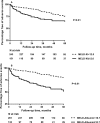Prognostic Value of Hepatorenal Function By Modified Model for End-stage Liver Disease (MELD) Score in Patients Undergoing Tricuspid Annuloplasty
- PMID: 30006492
- PMCID: PMC6064836
- DOI: 10.1161/JAHA.118.009020
Prognostic Value of Hepatorenal Function By Modified Model for End-stage Liver Disease (MELD) Score in Patients Undergoing Tricuspid Annuloplasty
Abstract
Background: The Model for End-stage Liver Disease excluding international normalized ratio (MELD-XI) score and the modified MELD score with albumin replacing international normalized ratio (MELD-Albumin) score, which reflect both liver and renal function, have been reported as predictors of adverse events in liver and heart disease. Nonetheless, their prognostic value in patients undergoing tricuspid annuloplasty has not been addressed.
Methods and results: A total of 394 patients who underwent tricuspid annuloplasty were evaluated. Baseline clinical, laboratory, and echocardiographic parameters were recorded. Adverse outcome was defined as the occurrence of heart failure requiring admission or all-cause mortality. Patients who underwent tricuspid annuloplasty had a high prevalence of preoperative hepatorenal dysfunction that was more common in patients with severe tricuspid regurgitation than those with mild to moderate tricuspid regurgitation. The MELD-XI and MELD-Albumin scores were excellent predictors of 1-year adverse outcome (area under the curve: 0.69 and 0.75, respectively). Kaplan-Meier survival curve demonstrated that a high score on MELD-XI (≥12.0) and MELD-Albumin (≥10.7) was associated with an increased risk of adverse events. During a median follow-up of 40 months, both MELD-XI and MELD-Albumin scores were significantly associated with adverse outcome, even after adjusting for potential confounding factors. Significant improvement of hepatorenal function at 1 year postoperation was noted only in patients who had no adverse events, not in those who experienced an adverse outcome.
Conclusions: Both MELD-XI score and MELD-Albumin score can provide useful information to predict adverse outcome in patients undergoing tricuspid annuloplasty. The present study supports monitoring of modified MELD score to improve preoperative risk stratification of these patients.
Keywords: Model for End‐stage Liver Disease; liver and renal dysfunction; outcome; tricuspid annuloplasty; tricuspid regurgitation.
© 2018 The Authors. Published on behalf of the American Heart Association, Inc., by Wiley.
Figures



Similar articles
-
Prognostic Role of Hepatorenal Function Indexes in Patients With Ebstein Anomaly.J Am Coll Cardiol. 2020 Dec 22;76(25):2968-2976. doi: 10.1016/j.jacc.2020.10.035. J Am Coll Cardiol. 2020. PMID: 33334426 Free PMC article.
-
Prognostic value of modified model for end-stage liver disease scores in patients with significant tricuspid regurgitation.Eur Heart J Qual Care Clin Outcomes. 2023 Apr 26;9(3):227-239. doi: 10.1093/ehjqcco/qcac027. Eur Heart J Qual Care Clin Outcomes. 2023. PMID: 35612991
-
Prognostic value of hepatorenal function following transcatheter edge-to-edge mitral valve repair.Clin Res Cardiol. 2021 Dec;110(12):1947-1956. doi: 10.1007/s00392-021-01908-w. Epub 2021 Jul 12. Clin Res Cardiol. 2021. PMID: 34254179 Free PMC article.
-
Accuracy of MELD scores in predicting mortality in decompensated cirrhosis from variceal bleeding, hepatorenal syndrome, alcoholic hepatitis, or acute liver failure as well as mortality after non-transplant surgery or TIPS.Dig Dis Sci. 2011 Apr;56(4):977-87. doi: 10.1007/s10620-010-1390-3. Epub 2010 Sep 16. Dig Dis Sci. 2011. PMID: 20844956 Review.
-
[Tricuspid valve regurgitation : Indications and operative techniques].Herz. 2017 Nov;42(7):653-661. doi: 10.1007/s00059-017-4603-0. Herz. 2017. PMID: 28801688 Review. German.
Cited by
-
Trends in hemoglobin-to- red cell distribution width ratio and its prognostic value for all-cause, cancer, and cardiovascular mortality: a nationwide cohort study.Sci Rep. 2025 Mar 5;15(1):7685. doi: 10.1038/s41598-025-92228-w. Sci Rep. 2025. PMID: 40044826 Free PMC article.
-
A streamlined, machine learning-derived approach to risk-stratification in heart failure patients with secondary tricuspid regurgitation.Eur Heart J Cardiovasc Imaging. 2023 Apr 24;24(5):588-597. doi: 10.1093/ehjci/jead009. Eur Heart J Cardiovasc Imaging. 2023. PMID: 36757905 Free PMC article.
-
Contemporary review in the multi-modality imaging evaluation and management of tricuspid regurgitation.Cardiovasc Diagn Ther. 2021 Jun;11(3):804-817. doi: 10.21037/cdt.2020.01.06. Cardiovasc Diagn Ther. 2021. PMID: 34295707 Free PMC article. Review.
-
The prognostic value of MELD-XI in elderly patients with ST-segment elevation myocardial infarction: an observational study.BMC Cardiovasc Disord. 2021 Jan 28;21(1):53. doi: 10.1186/s12872-021-01862-5. BMC Cardiovasc Disord. 2021. PMID: 33509076 Free PMC article.
-
Prognostic value of the dynamic hepatorenal function on intermediate-term mortality in TAVI patients with survival to discharge.Clin Cardiol. 2023 Jan;46(1):84-91. doi: 10.1002/clc.23940. Epub 2022 Nov 30. Clin Cardiol. 2023. PMID: 36448412 Free PMC article.
References
-
- Nath J, Foster E, Heidenreich PA. Impact of tricuspid regurgitation on long‐term survival. J Am Coll Cardiol. 2004;43:405–409. - PubMed
-
- Topilsky Y, Nkomo VT, Vatury O, Michelena HI, Letourneau T, Suri RM, Pislaru S, Park S, Mahoney DW, Biner S, Enriquez‐Sarano M. Clinical outcome of isolated tricuspid regurgitation. JACC Cardiovasc Imaging. 2014;7:1185–1194. - PubMed
-
- Baumgartner H, Falk V, Bax JJ, De Bonis M, Hamm C, Holm PJ, Iung B, Lancellotti P, Lansac E, Rodriguez Munoz D, Rosenhek R, Sjogren J, Tornos Mas P, Vahanian A, Walther T, Wendler O, Windecker S, Zamorano JL. 2017 ESC/EACTS Guidelines for the management of valvular heart disease. Eur Heart J. 2017;38:2739–2791. - PubMed
-
- Nishimura RA, Otto CM, Bonow RO, Carabello BA, Erwin JP III, Guyton RA, O'Gara PT, Ruiz CE, Skubas NJ, Sorajja P, Sundt TM III, Thomas JD. 2014 AHA/ACC guideline for the management of patients with valvular heart disease: a report of the American College of Cardiology/American Heart Association Task Force on Practice Guidelines. Circulation. 2014;129:e521–e643. - PubMed
-
- Vassileva CM, Shabosky J, Boley T, Markwell S, Hazelrigg S. Tricuspid valve surgery: the past 10 years from the Nationwide Inpatient Sample (NIS) database. J Thorac Cardiovasc Surg. 2012;143:1043–1049. - PubMed
Publication types
MeSH terms
Substances
LinkOut - more resources
Full Text Sources
Other Literature Sources

